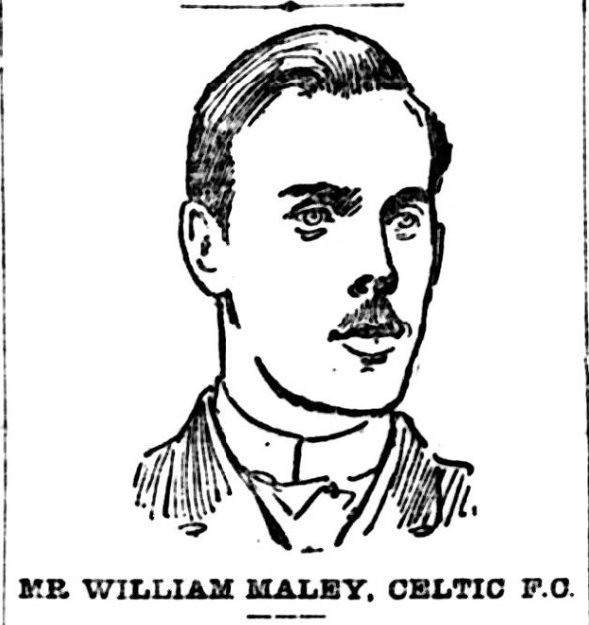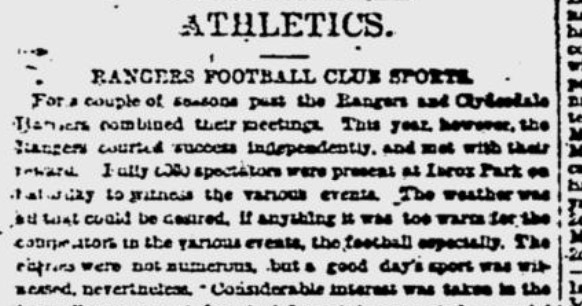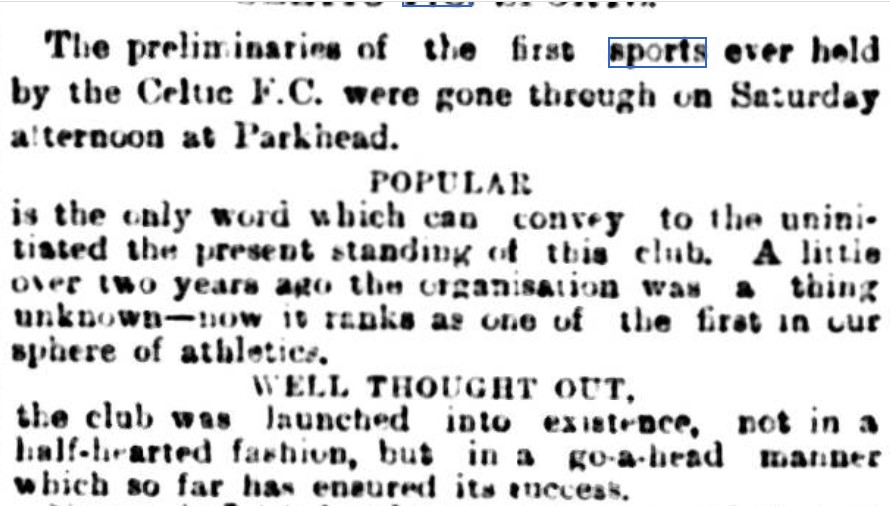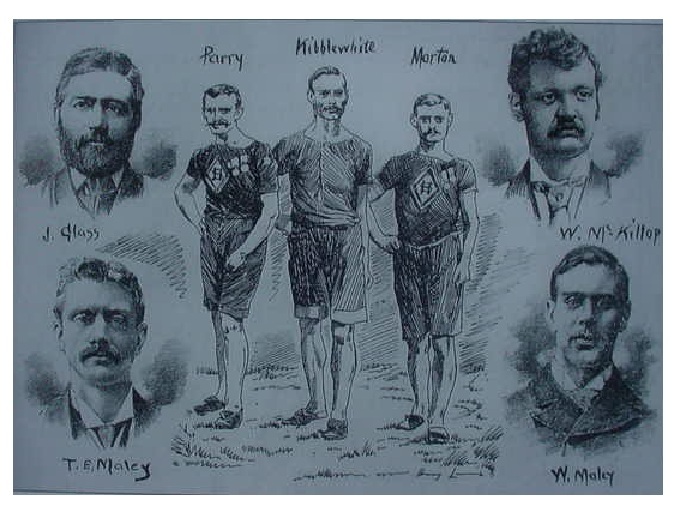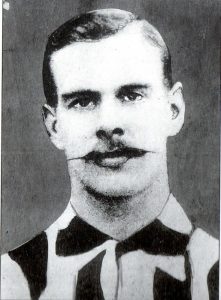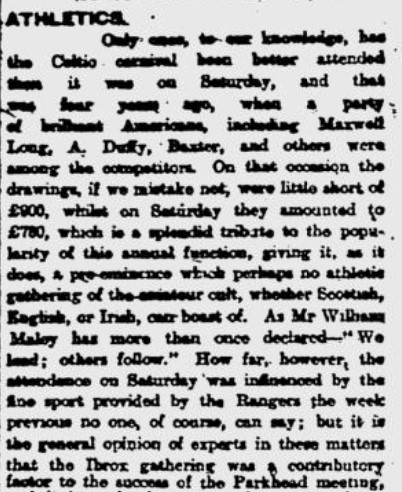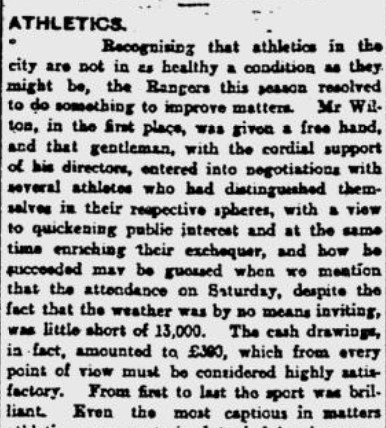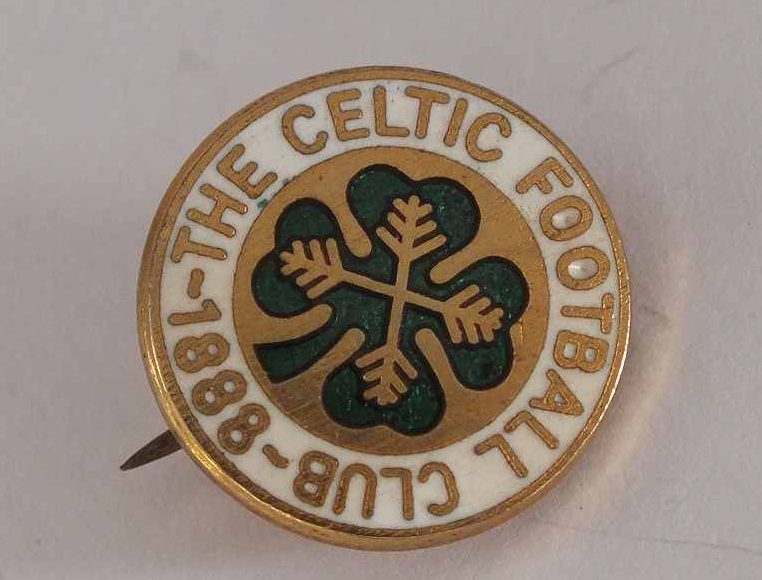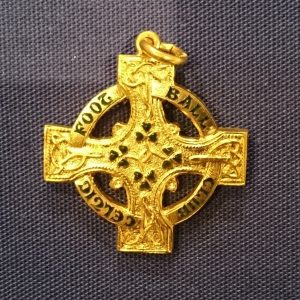We have seen that Willie Maley had a background in athletics, as well as in other sports such as cricket and football it has to be said, but what got him interested in sports promotion? The picture above is from the ‘Scottish Referee’ of August 1890 when he organised the first Celtic Sports. From the photographs available he looks a rather burly individual but the drawing indicated a more athletic figuire and a man who could win races. It was six years before he won the SAAU 100 yards. Football clubs had been organising amateur athletics meetings in various parts of the country – Kilmarnock, Edinburgh, Ayr, and of course in Glasgow where the Rangers FC Sports was the biggest meeting in the country. He had written a chapter for ‘Fifty Years of Athletics’, published by the SAAA covering the half centenary of that organisation. The article was called ‘Memories of a Sports Promoter’ in which he said –
“Tell how I got involved in athletics? A short story. Pride of place must be given to the lads of the village – Cathcart the village. We lads used up all our spare time in athletics. My strong suits were football, quoiting and running. I had even a short lived reputation as a cricketer.”
Andrew Dick, his boss in his office, signed him for Clydesdale Harriers and he ran cross-country and track until approached by the Celtic FC representatives, and “Celtic the new football club absorbed me and my time ever since. Why not sports for the new club? Why not, indeed! The MacLeans had their own boat, we will have our own sports. Hard work it was to convince the Committee, but ably backed up by my brother Tom and the late J.H. McLaughlin I succeeded. Some audacious deed was that. Our old enclosure at Dalmarnock Street was all right as a football ground, but as a sports holding enclosure it left much to be desired. Willing workers had made the ground; they did their best to produce a track. Certainly it did look well – so long as it was not used. It bore strong kinsmanship to a garden path. I am mindful of course that there were very few good tracks at that period. In the Western area, Hampden stood out as the best.”
As he said, other football clubs had their own sports meetings with the best in the west being Rangers, Queen’s Park and Morton while Hearts was the biggest in the east. But back to the first meeting. The Scottish Referee said in its issue of 4th August, 1890,
“On Saturday the Celtic Football Club made a beginning at sports holding and a promising one it was. Next Saturday the by event comes off and Celtic Park will be big-crowded indeed. The various events have been filled well, and sport will be good, in addition to which it is well to remember that the meeting will be under good management. Entries can yet be made with Mr William Maley.”
The Rangers had been holding their sports since the 1870’s and 1890’s version had been the week before this first Maley venture. It was also a bit different from past years, let the Glasgow Herald tell of it.
Celtic on the other hand had the preliminaries for their sports on that very day – 2nd August 1890 – with the following comment in the Scottish Referee:
The events at the ‘preliminaries’ which were confined included the 100 yards heats featuring Willie Maley who won his Heat as well as the Final and Tom Maley who was unplaced in his having been, as they say, handicapped out of it. There was also a 300 yards and a 220 yards in which they both ran. Tom was third in the 300 and Willie won the 220. There was also a 5-a-side tournament with Celtic No 1 playing Celtic No2 with Willie Maley scoring a point for No 1 and they won the match.
This report from the’ Scottish Referee’ of 11th August says: “The experiment made by the Celtic FC on Saturday of holding a sports meeting was fully justified by the magnificent success which attended the venture. We have witnessed all the leading athletic events this season but in point of enthusiasm we must give the palm to this immense gathering.”
The paper even gave three reasons for the triumph:
- The fact that it was the Celts’ debut on the path;
- The excellence of the sporting bill of fare;
- The value of the prizes “which the executive without regard to cost have secured.
Another feature in evidence was an earnest of what was to come while Maley was organising the sports was the appearance of Irish athletes. For instance Daniel Bulger raced in this meeting. Daniel Delany Bulger was a multi title winner from Dublin who had won the Gaelic Athletic Association 100 yards in `886, 1887, 1888, 1889 an 1890, and the Irish AAA’s 100 yards in 1888, 1889 and 1890 and the 220 yards, GAA, in 1885, 1886 and 1887, and IAAA in 1885. He was not the only nor was he the last. 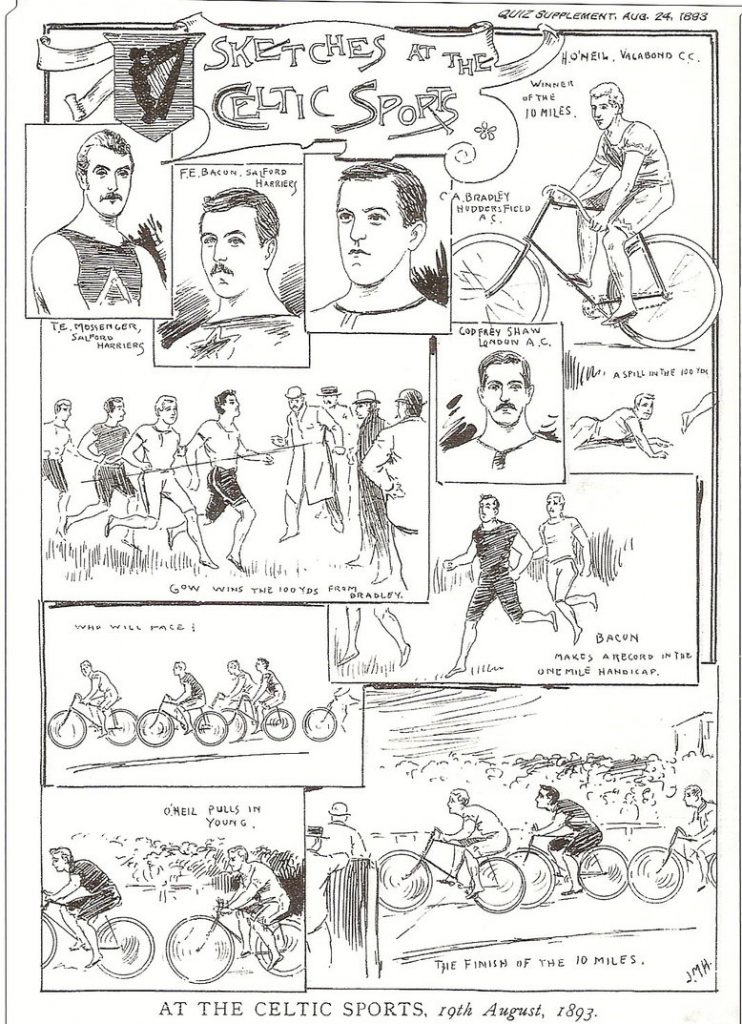
Cycling was a major draw at all big sports meetings of the day and Celtic supported the sport whole heartedly – note the cartoon for the 1893 sports above. The second Saturday in August 1893 saw Parkhead occupied by a match between Celtic and Queen’s Park so the Sports were shunted back a week. Given the standard of athlete promised, they were none the worse of it: the report in the ‘Glasgow Herald’ the following Monday began “The annual sports of the Celtic FC held at Parkhead on Saturday afternoon attracted the largest crowd ever witnessed at an athletic meeting in Scotland, it being estimated that 20,000 spectators were present. Nearly all the English and Irish cracks were present, and this, combined with the fine weather, no doubt partially accounted for the large attendance. The arrangements were excellently carried out by Mr William Maley and an able committee.”
The name Maley appeared in meeting previews and reports right from the start and kept on coming. In 1894 the preview of the 1894 sports in the ‘Scottish Referee’ waxed lyrical: “Celtic are busy completing their arrangements for their Saturday and Monday Carnival. To the club that has competed such athletic triumphs in the past, nothing is impossible, and, great though their previous records be, we expect from the labour and enterprise they have devoted to this meeting that it will result in all previous records being bust.
The grounds and tracks have been magnificently worked up by Master-of-Works McKay and all who are privileged to look upon them on Saturday will pronounce them the finest in Scotland if not in Britain. Mr W Maley is responsible for the list of attractions which are sufficient to please the daintiest athletic palate. It is indeed a meeting of the champions of champions, the creme de la creme of the Scottish, English and Irish athletic paths ….. The arrangements of the secretary, Mr William Maley, were excellent and the sports were an unqualified success. Representatives from the Queen’s Park, the Rangers and nearly all the leading clubs gave assistance in carrying out the programme. ” Not only was Willie organising the meeting but borthers Tom and Alex were both running in them by now.
Celtic had now held five successive and successful sports meetings – the enthusiasm and drive of W Maley had no little part in it but it is good to note the amount of help they received from other football and sports club personnel. Names like Gow and Vallance appear as officials as well as competitors, Farquhar Matheson and many other members of Clydesdale Harriers officiated every year (the Maley brothers and many others were members of the club before the Celtic FC appeared on the scene), men from Queen’s Park and other clubs were also in evidence.
“There will be no Irish competitors at the Celtic Sports on Saturday but it is just possible that one or two prominent Irish athletes may figure in the flat events. They of course run the risk of disqualification if they compete under the rules of an alien Union, but that would seem to have little or no terror for them. The Celtic, as is well known, have a powerful influence on Irish athletic circles, and from the temperament of the people across the channel all the restrictions in the world will not prevent the men from competing if they make up their mind to do so, and can find the time to travel to Scotland.
The Irish contingent w-as by 1995 an integral part of the Sports but sports have politics just like other important parts of our lives and the Press reported that year
“There will be no Irish competitors at the Celtic Sports on Saturday but it is just possible that one or two prominent Irish athletes may figure in the flat events. They of course run the risk of disqualification if they compete under the rules of an alien Union, but that would seem to have little or no terror for them. The Celtic, as is well known, have a powerful influence on Irish athletic circles, and from the temperament of the people across the channel all the restrictions in the world will not prevent the men from competing if they make up their mind to do so, and can find the time to travel to Scotland.
Scottish athletics had its problems – The top club in any sport, whether it be football, athletics or any other will be the subject of criticism and at times unfair discrimination. In 1895 Clydesdale Harriers was the strongest club in athletics and Celtic was one of the strongest in football. The Scottish Amateur Athletic Association was in dispute with the Scottish Cyclists Union which was allied to Clydesdale Harriers. One thing led to another and Clydesdale broke away from the SAAA. With powerful members of Celtic also members or former members of Clydesdale, eg the Maley brothers, PJ Gallagher, etc, the club left the SAAA and joined the Union. Many of the bigger Scottish football clubs also signed up for the SAAU. With the SAAA allied with the AAA in England and the IAAA in Ireland, it meant that no athlete of any club affiliated with these bodies could run at SAAU events without being disciplined by their governing body. Celtic were outside the SAAA pale and had cast their lot with the SAAU. Back to Scotland in 1895. But the sports at Parkhead went ahead and were again a success. On the day of Rangers Sports Willie was at Strathallan negotiating talent for the CFC Sports while Alex was at Ibrox booking athletes for Parkhead the following week. When the day came there was a sight seldom seen at any sports meeting: the team manager running in the competition and even winning a prize from a low mark. Willie Maley was second (scratch) in the first heat of the invitation 100 yards and second in the final, beaten by JB Auld (1 yard) with the first 4 all very close across the line. Winning time was 10.8 seconds. Another initiaprovided, it was certain to become and annual event.tive was the re-introduction of the steeplechase to a sports meeting and it was reported that after the amusement and entertainment it would be an essential part of future Sports.
Some competitors from the Celtic Sports, 1896:
SAAU Champion bottom right
That was nothing however compared to his running the following year when he won the SAAU 100 yards championship on 27th June, 1896, from the same JB Auld. It was almost certainly the first and last time that a Scottish football team manager had won a Scottish national 100 yards title. He ran in the 130 yards on the Monday supplementary meeting which had 66 runners. He was the only runner off scratch and although he made the final, he was ultimately unplaced. He kept on organising and running and on 9th August, 1897, Scottish Referee said “W Maley was at Newcastle on Saturday looking for talent and secured not a few stars.” The Glasgow Herald, also of 9th August, started its preview of the event
The sports were on Saturday, 14th August in 1897. as follows. “Everything the Celtic do, they do well; there are no half measures with them. Since the institution of their sports it has been a rule with them to introduce eminent athletes from England and Ireland . Bradley, Bacon, Perry, Wittenberg and Kibblewhite, an others of less note, have all helped to throw lustre over meetings at Parkhead from time to time, and though the amateurs of the present day are made of different stuff from these men, there are several who stand high in public favour, one or two of whom we are to have the pleasure of seeing on Saturday first.” It went on to name some of them, starting by saying that Bradley was not a certain starter, FW Cooper ( superb sprinter and Welsh rugby international), W Elliott, AAA quarter mile champion would run in the 300 yards, and W Tysoe would turn out in the 1000 and mile handicaps. They had invited 12 to 15 men to take part in the mile, including the three prize winners from the Rangers Sports the previous Saturday.
There was no doubt that he wanted the best available for the meetings – even recruiting competitors the week before the meeting. Remember that the meeting would have had 15,000 or more even without these late arrivals but the sport was the thing that seemed to move him. There had always been Irish athletes at the Celtic meeting but in 1899 a special effort was made.
“If records did not fall on Saturday at Parkhead like grouse on a Highland moor, the excellence of the sport was such as has not been equalled at any athletic function in Glasgow this season. Nor is this surprising when the eminence of some of the competitors is taken into account. Hitherto the Celts have culled from the rich athletic stores of England, but this season Mr William Maley has directed his attention to the not less wealthy resources of Ireland, several of whose more distinguished athletes accepted the invitation, and their presence more than anything else contributed so largely to the success of Saturday’s meeting. If there is any place in Scotland where those of Irish nationality are warmly received it is at Parkhead, which overflows with a kind of exile enthusiasm, making Irishmen feel thoroughly at home and inspiring them to lofty achievements.” The result of this drive, was the appearance of several top class athletes but none quite so celebrated as Denid Horgan. Horgan won a total 42 shot put titles during his athletic career, including 28 Irish championships, 13 English championships (all for the 16 pound shot) and one American championship.
Willie Maley
In 1900 the bill of fare at the Celtic Sports had a marvellous spread of international athletes on offer.
Willie Maley had been at the AAA’s Championships and ‘succeeded in inducing AF Duffy the 100 yards champion; W Long, 440 yards champion; John Flanagan, world’s record holder for hammer throwing; and John Bray, Canadian half-mile record holder, to compete at the Celtic Sports meeting on Saturday and Monday next. This is a big catch, and all interested in athletic science must be indebted to the Celts, and through the Celts to Mr Maley for bringing such an accomplished quartette of athletes to Glasgow.’ There were of course events at the Celtic supplementary meeting the following Monday so, after they had all performed well on the Saturday Mr Maley had a surprise in store: “At the conclusion of the Celtic FC meeting on Saturday, Mr William Maley, accompanied by the American athletes, journeyed down to Rothesay for the week-end. They will be back fresh and well for tonight’s meeting, when no doubt they will again accomplish some startling performances, so be sure you do not miss this treat.” Going to London, signing the top talent, then schmoozing them after the Saturday so that they would perform well on the Monday. Not many tricks being missed by Maley – and note the upgrading of expectations – a few years earlier he had been at Strathallan signing up Scots, this time it was the White City and American athletes. The results of these meetings and others between 1900 and 1910 can be found at Celtic Sports: 1900 – 1910 – Anent Scottish Running
1901 was another good one with the Glasgow Herald saying: “It has been said by one whose opinion in athletic matters is valued highly that the Celtic meeting is the greatest in the country, and with the recollection of many fine gatherings which the club has celebrated, we are not inclined to question the verdict.” More Americans, more big crowds. And so it continued and in 1904 there was an attendance estimated at 30,000. 1902 was Coronation year and many events were cancelled because of that but Celtic went ahead with their Saturday and Monday Supplementary meetings as usual. The Monday evening meeting itself had a very good turnout with runners from England, Ireland and England all taking part along with big numbers of Scottish athletes (eg 18 heats of the 100 yards and 10 of the 220 yards). With the two major meetings of the year coming so close together (Rangers first Saturday and Celtic second Saturday) it was ever the case that the one would influence the other and the Glasgow Herald of 10th August 1903 started its report as follows:
The Rangers Sports the previous week had been good, very good: the same paper had reported
William Wilton was the mastermind behind the Rangers sports at that time and he and Maley had a good and friendly rivalry. At times one suspects that they co-operated to get some major talent to both meetings. A healthy competition between sports promoters is usually a good thing for the sport with each trying to out do the other in terms of athletic quality (star names, athletes from abroad), quantity of local athletes (20+ heats of the 100 yards, over 100 in the Mile, etc), big crowds to run before and in the quality of the prizes. Maley was a master in every department while Wilton would have done the sport proud in any generation.
There were stars aplenty in 1905 but from all over Britain and of those the brightest was Alfred Shrubb who had been a favourite in Glasgow for some time and particularly after his historic run at Ibrox in 1904. The field on the Monday evening four miles included such as John McGouch, Sam Stevenson and James Reston. Shrubb had come north specifically for the Celtic meeting and won the event from the specially selected field where the limit man had over a lap start in 19 minutes 34 seconds from McGough who set a Scottish record of 20:06.2. The following year – 1906, saw an even bigger star in Scottish eyes when Lt Halswell was the headline performer.
The Celtic Sports had been a late comer to the ranks of sports promoting clubs but was known a an innovator as far as organising and pleasing the public was concerned. From the Scottish Referee of 6th August 1906: “The entries for the Celtic Sports promise to be as large as previous years whilst the quality of the sport to be provided looks like being a record. The Celtic open handicaps have always been the aim of Scotch athletes and this year seems likely to supply very keen racing. The Celts have led the way in sports promoting, and in the way of special events such as invitation handicaps and scratch races, and have this year no less than eight such special tit-bits. They have also arranged to take over the Western District SCU championship for quarter mile.” The SCU was the Scottish Cyclists Union and cycling was a big draw at sports at the time. On the running side of things, they had Lt Halswell/ He had run disappointingly at the Rangers Sports the previous weekend but he was to race in three events at Parkhead The report read:
“Lieutenant Halswell was the “magnet” and it goes without saying that he rose to the dignity of the occasion. He gave no fewer than three very noble turns, all of which were greatly appreciated, though of course the one that caught the fancy most was the 49 sec in the quarter mile, which is three-fifths better than his previous accomplished if we mistake not, in the West of Scotland Harriers June Sports at Ibrox Park. Halswell on Saturday could have easily given the concessions that proved too severe for him at Ibrox, so full of life was he at the finish. He was also second in the invitation 100 yards off one and a half yards, and was just defeated in the half-mile scratch by George Butterfield of Darlington Harriers in 2 min”
And Maley was given most of the credit for the continued success of the meeting. The badge below, which we have courtesy of Hugh Barrow, is from Halswell’s trophy cabinet. 20 years of promoting sports meetings and there were still initiatives and enthusiasm being shown by the managers.
Success followed success for both clubs with Wilton and Maley competing for the public support and, say it quietly, maybe co-operating to bring top sportsmen to Glasgow on successive Saturdays. What persuaded them to spend a week in Glasgow? Read this one:
Last week was a memorable one in the sporting history of the city, [reported the Glasgow Herald of 10th August 1908]. On Monday the Rangers FC concluded what from every point of view had been the most successful meeting that they had held for a very long time, while on Saturday Celtic FC added one more to their brilliant list of triumphs. Both are in the fortunate position of having money to spend, and money judiciously handled will yield, as we have just seen, as big a return from athletics as from most forms of public amusement. That there was more lavish expenditure this season than previously is frankly acknowledged by the two managements and, without pausing to inquire how this sort of thing squares with official notions, we would merely mention that the Glasgow public has much to be grateful for to the Rangers and Celtic for introducing so many of those who distinguished themselves at the recent Olympic Games. But for those clubs it is just possible that we might never have had the privilege of seeing Melvin Sheppard, Reginald Walker and others who, by their achievements at the stadium, have enrolled themselves in the lists of the immortals.
The Press was not slow to identify those responsible for the magnificent meetings being held and after the 1910 events, the Glasgow Herald said: “Considering the magnitude of the programme, the arrangements were highly creditable to Mr W Maley who deserves special credit for the triumph which crowned his labours on Saturday.”
1911 was a big one for the club and no effort was spared for the sports and the Glasgow Herald reporter started his article thus:
“Besides FL Ramsdell, HE Gissing and JJ Flanagan of America, several distinguished English athletes and cyclists took part in the annual sports of Celtic FC at Parkhead on Saturday and, as a consequence, competition in many events was very much above the average of what is usually witnessed in the city, celebrated as it is for its rare sporting associations. The Celtic management spare neither money nor time in connection with their sports, and this season by way of celebrating an interesting epoch in their history, they extended more invitations than they usually do, with the result that Saturday’s meeting in many respects will hold a cherished position in the club’s records. Large as the attendance was, it it would have been larger still but for the tramway strike. As it was, the official estimate was 30,000. The arrangements of Mr Maley were in advance of anything previously witnessed at Parkhead, and when we mention that over and above football there were 53 different events all of which were disposed of in three hours and a half, it will be admitted that there has been nothing better in the way of athletics management seen in the city. Every item was so rapidly dealt with that there was scarcely any time for reflection. “
There were at least three Olympians – two of them American – competing and the open handicap events were well supported too. Maley is mentioned here yet again. By now he was a fixture on the SAAA General Committee and he would go on to be an honorary life vice-president and and later President of the body. The sports went on with top runners from all over the world. 1912 was an Olympic year and there were Olympic athletes from America, Ireland and Germany as well as from the UK. You can read a complete report at this link. We have already mentioned that athletes often competed at both venues as Wyndham Halswell had done already. In Olympic year there were several Olympic athletes, and not a few who had been contenders for a place, who competed in the two meetings, with the half mile being the outstanding example. At Ibrox on the first Saturday in the month the 880 yards featured Mel Sheppard (USA), Hans Braun (Germany), JL Meredith (USA alongside DF McNicol and George Dallas, the latter being second in the invitation handicap race, and at Parkhead the first three in the half mile were Sheppard, Braun and Meredith. There surely must have been some collaboration between both sets of promoters to cover the legitimate travelling and accommodation expenses of these athletes. The following year the outstanding sprinter W Applegarth ran at both meetings, and in 1914 an even better American middle distance runner ran at both Games – he was Homer Baker who was “much pleased with the cordiality experienced at Ibrox and Parkhead and the hospitality of the Celtic will remain in his own words “a cherished memory for years.”
The War started later that year and that changed things a bit – and it was also the year that a former professional runner called Bill Struth arrived at Ibrox as an assistant manager, meanwhile William Wilton remained at the helm of the very successful Rangers Sports. Maley remained at Celtic of course.
For more about the Celtic Sports, follow this link. for the 1890-94 sports, this one for the 1895-1900 and all the others are also on the website www.anentscottishrunning.com if you type in Celtic Sports at the top of the page.
